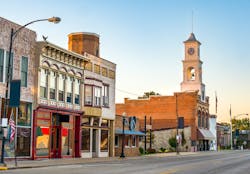Implementing Lighting Controls in Smaller Buildings
A revolution in illumination was underway a decade or so ago, as companies, universities, and retailers began swapping out energy-wasting fluorescent and incandescent lamps for super-efficient light-emitting diode (LED)-based luminaires and lamps. Using about 75% less electricity and lasting up to 25 times longer than their incandescent counterparts, LEDs quickly grew in popularity. Today, they now dominate the commercial and industrial lighting market.
As first-generation LEDs reach the end of their useful lives, there’s a rare opportunity to significantly boost the energy efficiency of commercial lighting systems by pairing the installation of new LEDs with networked lighting controls (NLCs).
A recent study published by the DesignLights Consortium (DLC) and Northwest Energy Efficiency Alliance found that installing NLCs and LEDs together yields dramatic increases in energy efficiency — making LED luminaires up to 70% more efficient in some building types and averaging 47% across eight categories of facilities (Photo 1). Since LED luminaires installed today may last another decade, new LED products should be dimmable and combined with controls from the outset to avoid sacrificing the increased energy savings and occupant comfort, security, and well-being enabled by advanced controls.
For reasons ranging from upfront costs to unfamiliarity with the technology, however, connected lighting comprises less than 1% of all luminaires in the United States, according to the Department of Energy (DOE) — and uptake is notably lacking in the smaller building sector. For buildings under 50,000 square feet, which comprise 90% of U.S. commercial buildings according to the U.S. Energy Information Administration, more than half (about three million buildings) have no lighting control strategies beyond a simple on-off switch (Photo 2).
The DOE is seeking to change this narrative for commercial buildings of all sizes. Through controlled, connected lighting, the agency estimates the United States could avoid about one quad of electricity consumption (approximately equal to one-fifth of the country’s commercial sector energy use) and save more than $10 billion in annual energy costs by 2035 when just under a third of installed luminaires in commercial buildings are expected to have network connectivity.
In addition to expanded energy savings, combining NLCs with LED luminaires unleashes an array of non-energy benefits that, in some cases, eclipse the value of energy savings alone. A DLC study published in January 2023 found that considering the net value of an NLC’s non-energy benefits, such as longer equipment lifecycles and safety and security gains, could provide an additional 30% value to a building owner.
Despite these benefits and incentives offered by more than 50 electric utilities across the country, lighting decision-makers haven’t sufficiently warmed to NLC technology, especially in the small- to medium-sized building sector.
How to improve this situation was a main topic of discussion at a DLC meeting in Boston last May attended by electric utility officials, energy efficiency professionals, lighting manufacturers/distributors, researchers, and other industry representatives. To attract more small building lighting decision-makers to the technology, one theme prevailed: Lower the barrier of entry, and keep it simple.
That message resonated with the DLC, a non-profit organization that collaborates with utilities, energy efficiency programs, manufacturers, lighting designers, building owners, and government entities to create rigorous lighting performance criteria that keep pace with technology. Over the past several months, the DLC has been developing a new program geared toward supporting the implementation of lighting control strategies in buildings under 50,000 square feet served by the retrofit market. Out for stakeholder comment this spring, the proposed policy aims to answer questions, provide resources, and open lines of communication needed for smaller facilities to reap the energy and non-energy benefits of NLCs.
The crux of the new offering is the creation of tools containing all the information needed for energy efficiency incentive programs to evaluate retrofit projects and for installers to order materials and install/program a lighting control system. The proposed tools will feature a project intake form that includes all details about a lighting control retrofit project, including room-by-room details and an energy savings calculator. Project leaders will be able to choose how deep they want to go with energy savings, ranging from meeting the local energy code to significantly exceeding it. These preferences will inform a materials list (more sensors, for example, in a more aggressive scenario) and a sequence of operations provided for the project.
Specific features aimed at smoothing the way for small building NLC installations include generating individual forms listing the luminaires and sequence of operations for each room in a project, which would simplify a foreman’s assignment of work to project installers. The tool will also generate material lists that project leaders can give lighting distributors. Material lists will include verification that products being installed are on the DLC Qualified Products Lists relied upon by scores of energy efficiency incentive programs, thereby streamlining the rebate process. In addition, the program will generate leave-behind sheets for building owners/occupants, helping them understand the work that’s been done and how it may impact their future work environment.
The DLC is conducting pilot projects to ensure that this end product includes everything needed to maximize its usefulness and effectiveness for installers and incentive programs. Additional lighting control projects interested in piloting the DLC’s tools during this process are encouraged to email this author.
An array of technology and cost issues currently discourage most small- to medium-sized building decision-makers from embracing the transformative benefits of NLCs. We’re confident this new program, rolled out during 2023, will usher in the changes needed to shift that paradigm.
Jason Jeunnette is the DesignLights Consortium’s technical manager for building integration and controls. He can be reached at [email protected].
About the Author

Jason Jeunnette
Jason Jeunnette is the DesignLights Consortium’s technical manager for building integration and controls. He can be reached at [email protected].


